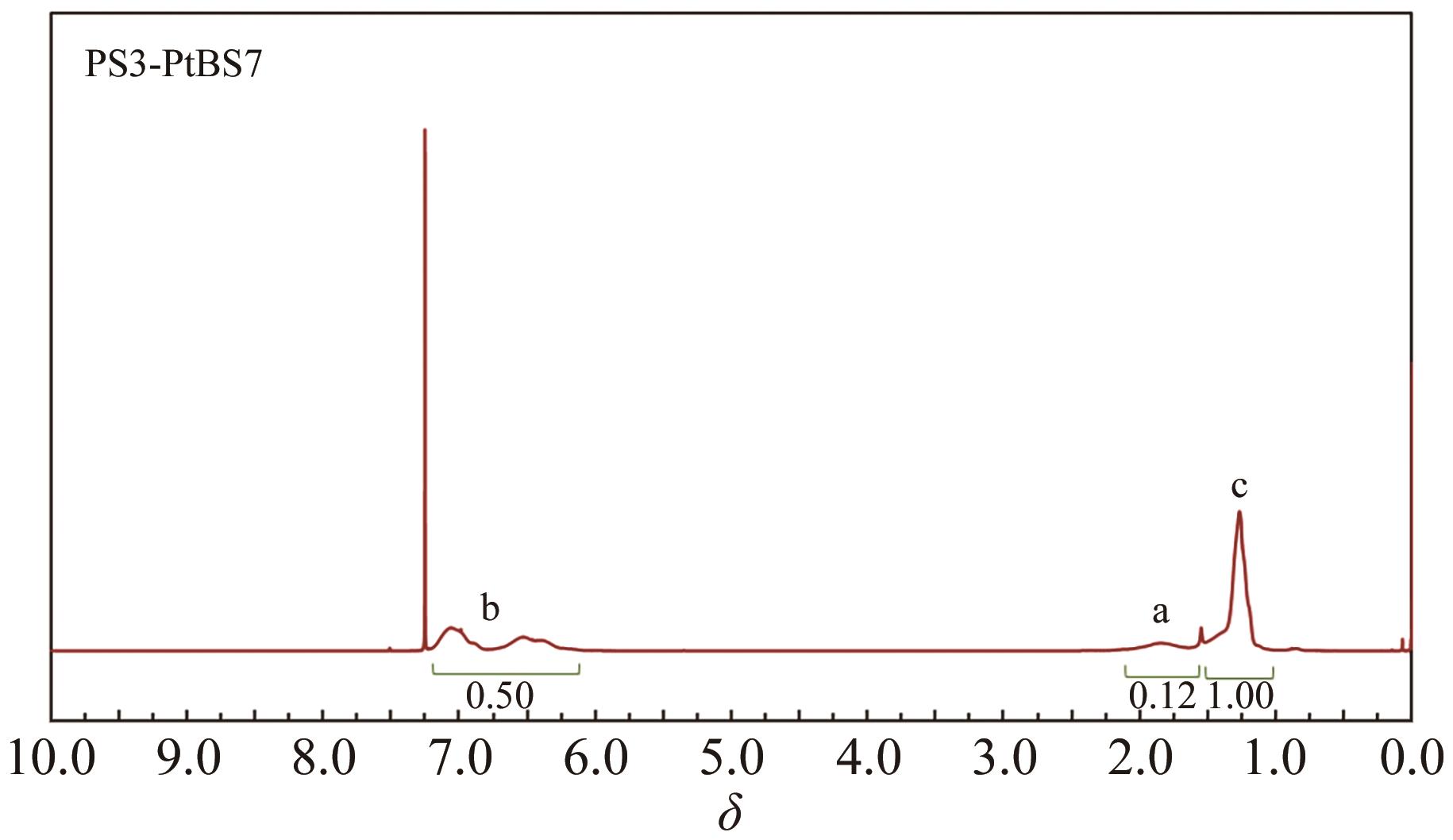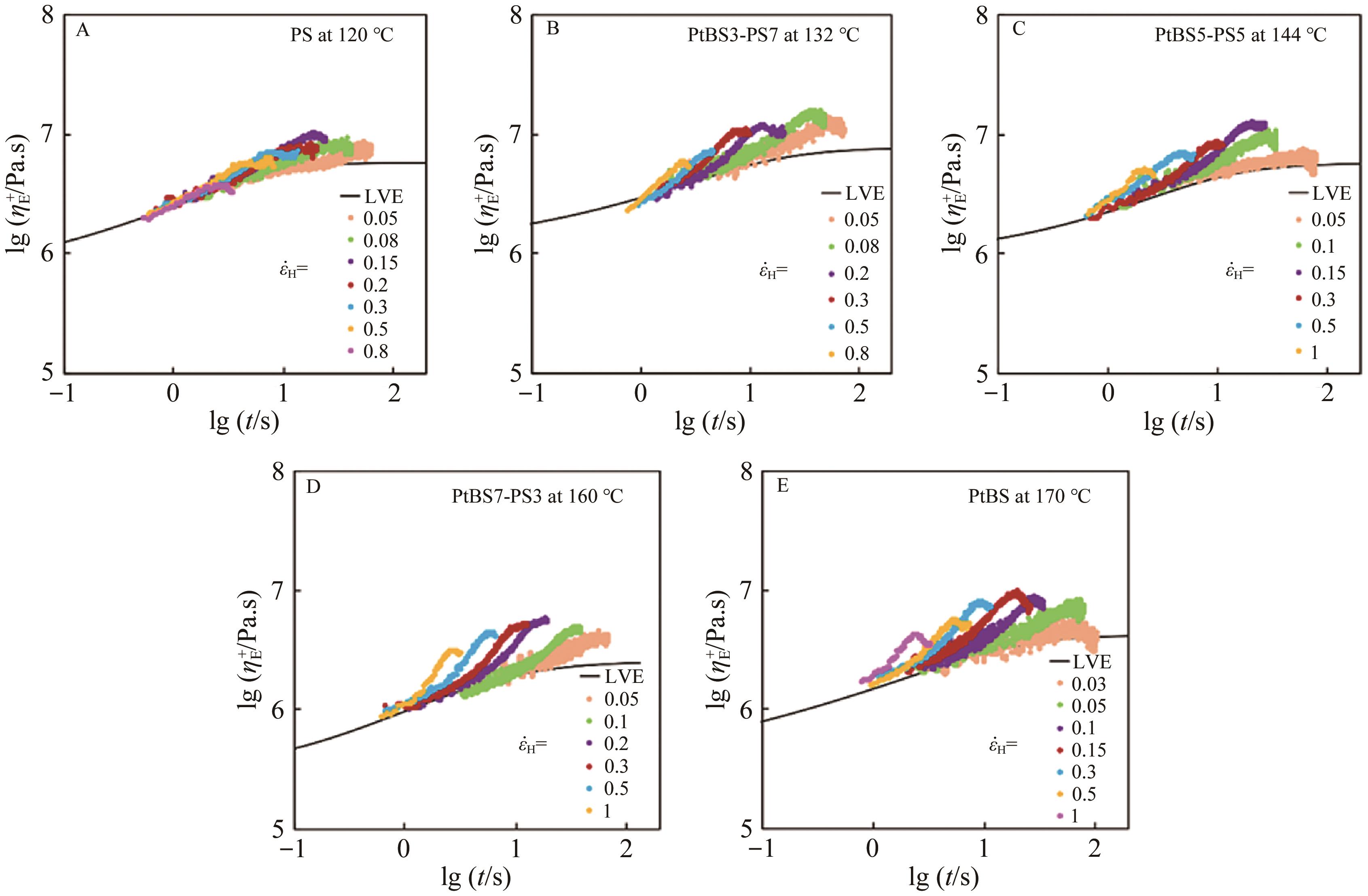
Chinese Journal of Applied Chemistry ›› 2024, Vol. 41 ›› Issue (8): 1098-1106.DOI: 10.19894/j.issn.1000-0518.240050
• Full Papers • Previous Articles Next Articles
Nonlinear Elongational Rheology of Unentangled Poly(styrene-co-p-tert butyl styrene) Copolymers
Zong-Hao HONG1,2, Shi-Long WU1( ), Quan CHEN1,2(
), Quan CHEN1,2( )
)
- 1.State Key Laboratory of Polymer Physics and Chemistry,Changchun Institute of Applied Chemistry,Chinese Academy of Sciences,Changchun 130022,China
2.School of Applied Chemistry and Engineering,University of Science and Technology of China,Hefei 230026,China
-
Received:2024-02-07Accepted:2024-06-14Published:2024-08-01Online:2024-08-27 -
Contact:Shi-Long WU,Quan CHEN -
About author:slwu@ciac.ac.cn
qchen@ciac.ac.cn
-
Supported by:the National Natural Science Foundation of China(52103021)
CLC Number:
Cite this article
Zong-Hao HONG, Shi-Long WU, Quan CHEN. Nonlinear Elongational Rheology of Unentangled Poly(styrene-co-p-tert butyl styrene) Copolymers[J]. Chinese Journal of Applied Chemistry, 2024, 41(8): 1098-1106.
share this article
Add to citation manager EndNote|Ris|BibTeX
URL: http://yyhx.ciac.jl.cn/EN/10.19894/j.issn.1000-0518.240050
| Samples | fPtBS/% | Mn/(kg·mol-1) | Mw/(kg·mol-1) | PDI | Tg/℃ | nK | τR /s |
|---|---|---|---|---|---|---|---|
| PS | 0 | 19 | 24 | 1.26 | 102 | 26 | 0.001 |
| PS7-PtBS3 | 35 | 23 | 29 | 1.26 | 115 | 27 | 0.008 |
| PS5-PtBS5 | 54 | 29 | 35 | 1.22 | 123 | 30 | 0.09 |
| PS3-PtBS7 | 74 | 38 | 49 | 1.29 | 132 | 37 | 0.63 |
| PtBS | 100 | 38 | 46 | 1.21 | 145 | 30 | 9.42 |
Table 1 Important parameters of the samples
| Samples | fPtBS/% | Mn/(kg·mol-1) | Mw/(kg·mol-1) | PDI | Tg/℃ | nK | τR /s |
|---|---|---|---|---|---|---|---|
| PS | 0 | 19 | 24 | 1.26 | 102 | 26 | 0.001 |
| PS7-PtBS3 | 35 | 23 | 29 | 1.26 | 115 | 27 | 0.008 |
| PS5-PtBS5 | 54 | 29 | 35 | 1.22 | 123 | 30 | 0.09 |
| PS3-PtBS7 | 74 | 38 | 49 | 1.29 | 132 | 37 | 0.63 |
| PtBS | 100 | 38 | 46 | 1.21 | 145 | 30 | 9.42 |
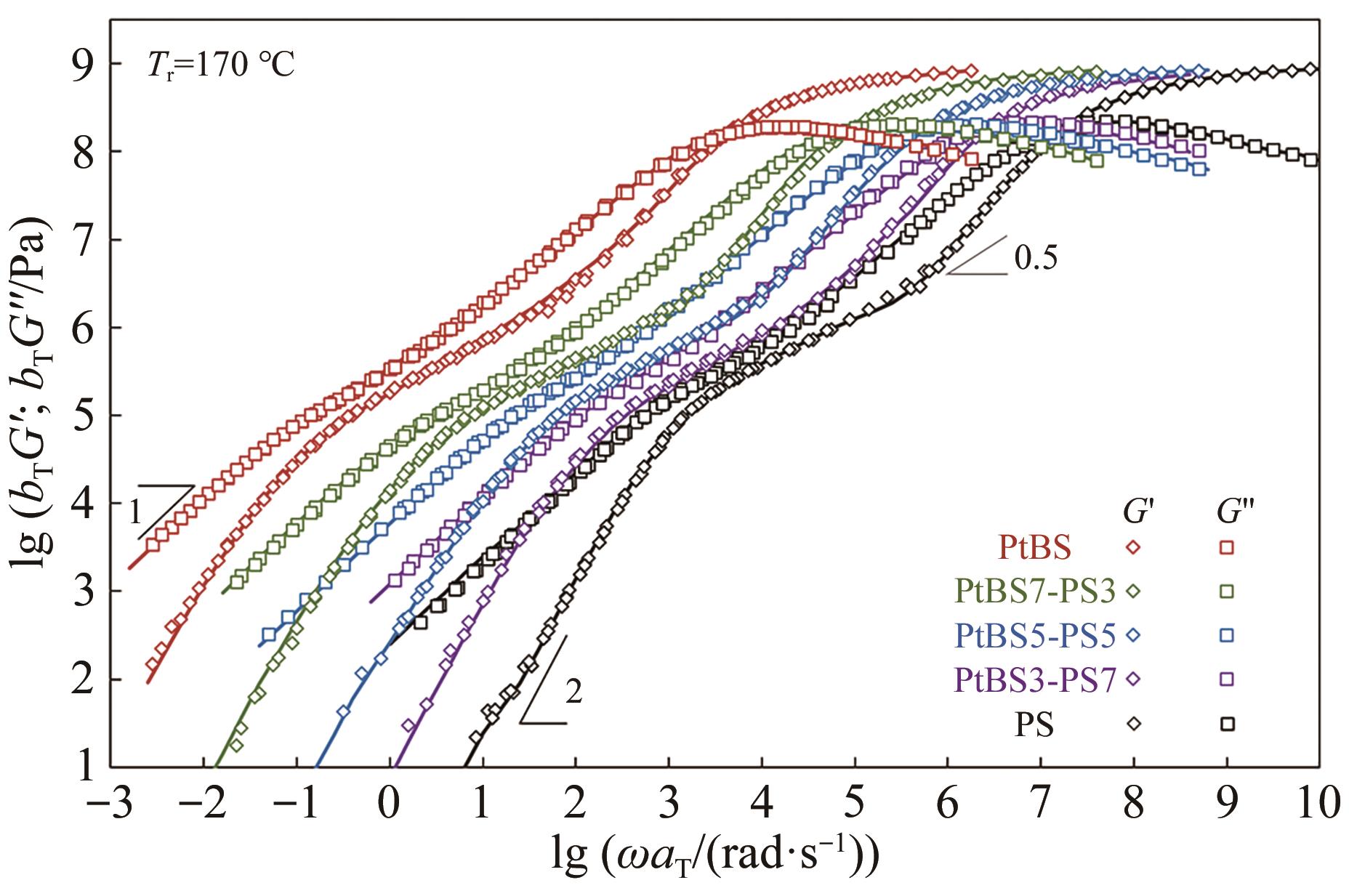
Fig.4 LVE bTG'(diamond symbol) and bTG"(square symbol) master curves of the PS, PtBS, and their copolymer samples reduced at Tr=170 ℃ (wherein bTG' and bTG" are plotted against reduced frequency ωaT, the solid curves are fits to Eqs (1) and (2))
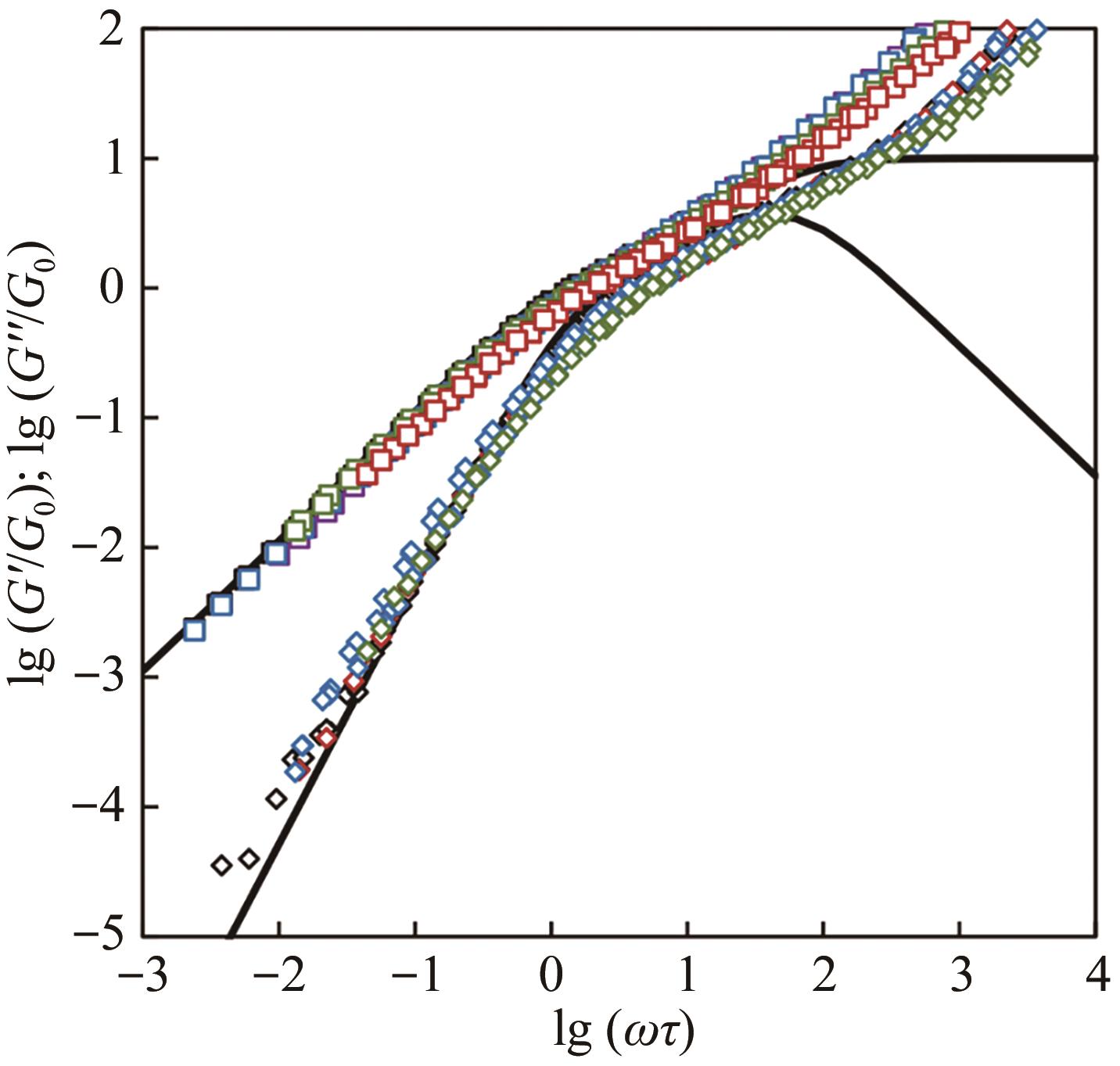
Fig.5 Comparison of normalized LVE master curves of the PS, PtBS, and their copolymer samples reduced at Tr=170 ℃, wherein G'Mw/ρRT and G"Mw/ρRT are plotted against reduced frequency ωτ, and G0=ρRT/Mw. The solid curves are fits to Eqs (3) and (4)
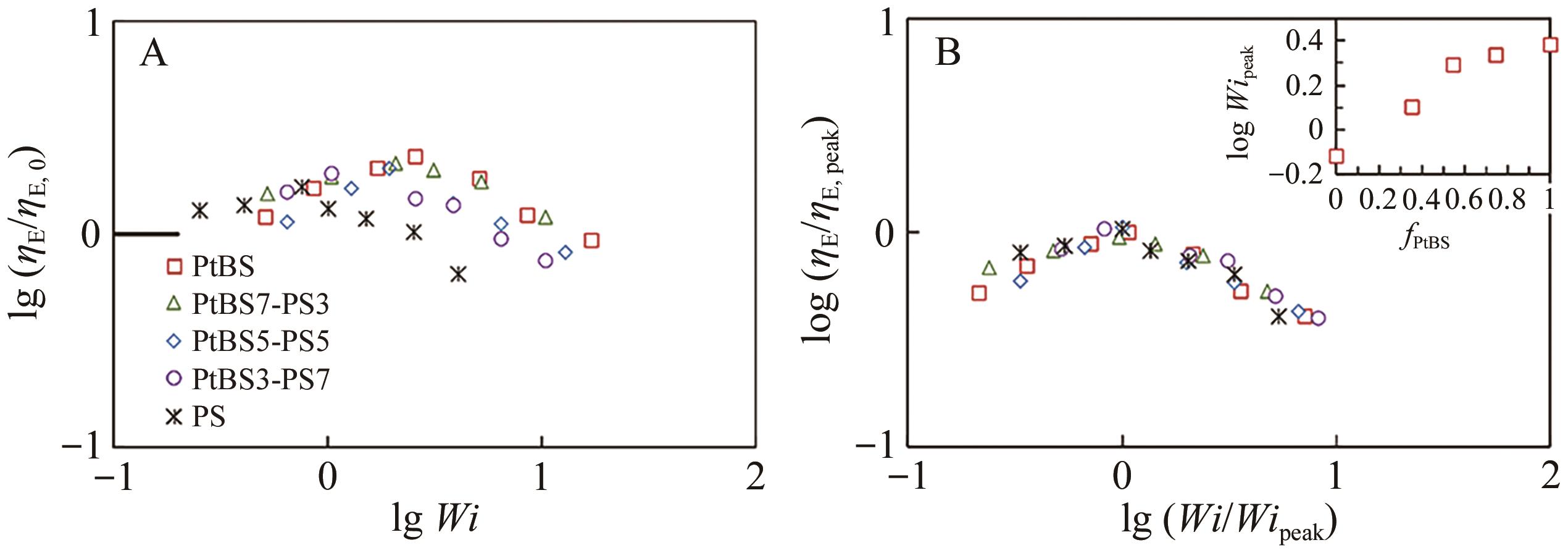
Fig.7 (A) Plots of normalized steady-state viscosity ηE/ηE,0 against Wi for PS, PtBS, and their copolymers; (B) Plots of ηE/ηE,peak against normalized Weissenberg number Wi/Wipeak, wherein ηE,peak and Wipeak are the viscosity and Weissenberg number at the peak of ηE+,respectively
| 1 | COSTANZO S, HUANG Q, IANNIRUBERTO G, et al. Shear and extensional rheology of polystyrene melts and solutions with the same number of entanglements[J]. Macromolecules, 2016, 49(10): 3925-3935. |
| 2 | YAOITA T, ISAKI T, MASUBUCHI Y, et al. Primitive chain network simulation of elongational flows of entangled linear chains: role of finite chain extensibility[J]. Macromolecules, 2011, 44(24): 9675-9682. |
| 3 | IANNIRUBERTO G. Quantitative appraisal of a new ccr model for entangled linear polymers[J]. J Rheol, 2015, 59(1): 211-235. |
| 4 | MARRUCCI G, IANNIRUBERTO G. Interchain pressure effect in extensional flows of entangled polymer melts[J]. Macromolecules, 2004, 37(10): 3934-3942. |
| 5 | IANNIRUBERTO G, BRASIELLO A, MARRUCCI G. Friction coefficient does not stay constant in nonlinear viscoelasticity[C]. 7th Annual European Rheology Conference, 2011: 61. |
| 6 | NIELSEN J K, RASMUSSEN H K, HASSAGER O. Stress relaxation of narrow molar mass distribution polystyrene following uniaxial extension[J]. J Rheol, 2008, 52(4): 885-899. |
| 7 | HUANG Q, HENGELLER L, ALVAREZ N J, et al. Bridging the gap between polymer melts and solutions in extensional rheology[J]. Macromolecules, 2015, 48(12): 4158-4163. |
| 8 | HUANG Q, MEDNOVA O, RASMUSSEN H K, et al. Concentrated polymer solutions are different from melts: role of entanglement molecular weight[J]. Macromolecules, 2013, 46(12): 5026-5035. |
| 9 | MATSUMIYA Y, WATANABE H, MASUBUCHI Y, et al. Nonlinear elongational rheology of unentangled polystyrene and poly(p-tert-butylstyrene) melts[J]. Macromolecules, 2018, 51(23): 9710-9729. |
| 10 | MAYS J W, FERRY W M, HADJICHRISTIDIS N, et al. Solution properties and chain flexibility of poly(para-tert-butylstyrene)[J]. Polymer, 1986, 27(1): 129-132. |
| 11 | JE M. Physical properties of polymers handbook[M]. New York: Springer, 2007: 447-453. |
| 12 | BRANDRUP J. Polymer handbook[M]. Chichester: Wiley-Interscience, 1989: 745-760. |
| 13 | 王小燕. 甲基丙烯酸二甲氨基乙酯的可逆加成断裂链转移自由基聚合及其嵌段共聚物的合成[J]. 石油化工, 2005, 34(6): 536-540. |
| WANG X Y. Reversible addition broken chain transfer radical polymerization of dimethylaminoethyl methacrylate and synthesis of its block copolymers[J]. Petrochem Eng, 2005, 34(6): 536-540. | |
| 14 | YANG J C, JABLONSKY M J, MAYS J W. NMR and FT-IR studies of sulfonated styrene-based homopolymers and copolymers[J]. Polymer, 2002, 43(19): 5125-5132. |
| 15 | SASAKI T, ICHIMURA M, IRIE S. Correlation between fragility and cooperativity in segmental dynamics of glass-forming para-substituted polystyrenes[J]. Polym J, 2015, 47(10): 687-694. |
| 16 | LO C T, CHOU P W. Effect of molecular properties of random copolymers on the stability and domain dimension of block copolymer/random copolymer blends[J]. J Phys Chem B, 2014, 118(44): 12763-12771. |
| 17 | CHEN Q, MATSUMIYA Y, MASUBUCHI Y, et al. Component dynamics in polyisoprene/poly(4-tert-butylstyrene) miscible blends[J]. Macromolecules, 2008, 41(22): 8694-8711. |
| 18 | CHEN Q, UNO A, MATSUMIYA Y, et al. Viscoelastic mode distribution of moderately entangled linear polymers[J]. Nihon Reoroji Gakkaishi, 2010, 38(4/5): 187-193. |
| 19 | 杨欢欢, 吴世龙, 陈红兵, 等. 非缠结缔合高分子的熔体拉伸性能[J]. 中国科学(化学), 2023, 53(4): 580-593. |
| YANG H H, WU S L, CHEN H B, et al. Advances in the extension rheology of unentangled associative polymer[J]. Sci Sin Chim, 2023, 53(4): 580-593. | |
| 20 | 刘凡, 黄绍永, 陈全. 聚左旋乳酸遥爪离聚物的静态结晶及剪切诱导结晶行为[J]. 应用化学, 2023, 40(10): 1412-1419. |
| LIU F, HUANG S Y, CHEN Q. Static Crystallization and shear induced crystallization of the poly(L-lactic acid)telechelic ionomer[J]. Chin J Appl Chem, 2023, 40(10): 1412-1419. | |
| 21 | ELLISON C J, MUNDRA M K, TORKELSON J M. Impacts of polystyrene molecular weight and modification to the repeat unit structure on the glass transition-nanoconfinement effect and the cooperativity length scale[J]. Macromolecules, 2005, 38: 1767-1778. |
| 22 | KIM S, LEE M, KIM H C, et al. Determination of glass transition temperatures in bulk and micellar nanoconfined polymers using fluorescent molecular rotors as probes for changes in free volume[J]. Macromolecules, 2023, 56(16): 6290-6304. |
| 23 | ZHANG X Z, LU Z Y, QIAN H J. Temperature transferable and thermodynamically consistent coarse-grained model for binary polymer systems[J]. Macromolecules, 2023, 56(10): 3739-3753. |
| 24 | 张妍洁, 陈全. 非缠结对称缔合链在蠕变过程中的动力学行为研究[J]. 高分子学报, 2021, 52(7): 796-805. |
| ZHANG Y J, CHEN Q. Creep dynamics of non-entangled symmetric associative polymers[J]. Acta Polym Sin, 2021, 52(7): 796-805. | |
| 25 | 刘双, 曹晓, 张嘉琪, 等. 流变技术在高分子表征中的应用:如何正确地进行剪切流变测试[J]. 高分子学报, 2021, 52(4): 406-422. |
| LIU S, CAO X, ZHANG J Q, et al. Toward correct measurements of shear rheometry[J]. Acta Polym Sin, 2021, 52(4): 406- 422. | |
| 26 | VAN DER VORST B, MATTHIJS TOOSE E, VAN DEN ENDE D, et al. Generalized rouse model for a dilute solution of clustered polymers[J]. Rheolog Acta, 1995, 34(3): 274-280. |
| 27 | GRAESSLEY W. The entanglement concept in polymer rheology[M]. Berlin: Springer-Verlag, 1974: 1-147. |
| 28 | WU S, CAO X, ZHANG Z, et al. Molecular design of highly stretchable ionomers[J]. Macromolecules, 2018, 51(12): 4735-4746. |
| 29 | IANNIRUBERTO G, BRASIELLO A, MARRUCCI G. Modeling unentangled polystyrene melts in fast elongational flows[J]. Macromolecules, 2019, 52(12): 4610-4616. |
| 30 | SCHROEDER C M. Single polymer dynamics for molecular rheology[J]. J Rheol, 2018, 62(1): 371-403. |
| 31 | LARSON R G. The rheology of dilute solutions of flexible polymers: progress and problems[J]. J Rheol, 2005, 49(1): 1-70. |
| 32 | DOYLE P S, SHAQFEH E S G, MCKINLEY G H, et al. Relaxation of dilute polymer solutions following extensional flow[J]. J Non-newtonian Fluid Mech, 1998, 76(1/2/3): 79-110. |
| 33 | MORELLY S L, PALMESE L, WATANABE H, et al. Effect of finite extensibility on nonlinear extensional rheology of polymer melts[J]. Macromolecules, 2019, 52(3): 915. |
| Viewed | ||||||
|
Full text |
|
|||||
|
Abstract |
|
|||||
